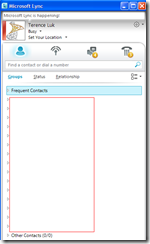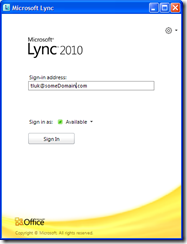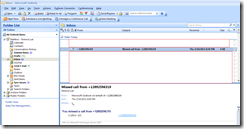I was talking to a fellow Microsoft UC consultant the other day about how:
- Missed call notifications
- Voicemail message delivery
… worked and realized that I had problems remembering the details of the differences between the 2 and while most of it came back after thinking about it for 10 minutes, I thought it would benefit myself as well as the community if I document it here.
I believe that the best way to start is to outline the scenarios when you have Exchange 2007 / 2010 and OCS 2007 R2 / Lync Server 2010 as your PBX and voicemail solution. Just so I don’t keep flipping around between the different versions, for the purpose of this example, we will use Exchange 2007 UM and Lync Server 2010 as the voicemail and PBX solution.
Lync Client Signed
Scenario 1:
- User calls in
- Rings until user gets directed to voicemail greeting
- Leaves a voicemail message
Looking into the C:Program FilesMicrosoftExchange ServerUnifiedMessagingvoicemail folder will show 2 files:
- <GUID>.txt
- <GUID>.wav
Opening up the <GUID>.txt file will show something similar to this:
MessageType : VoiceMail
CallerId : +12892596319
NDRRequired : False
RecipientName : Terence Luk
RecipientAddress : tluk@domain.com
RecipientCulture : en-US
CallId : ad0f59fc-6798-48ac-92e5-8b31d1a7fc1e
AttachmentName : E:Program FilesMicrosoftExchange ServerUnifiedMessagingvoicemailefad5c6d-e09b-43b1-b601-3291e3647b58.wav
Duration : 1
Important : False
CallAnswering : True
Codec : Gsm
Callee’s Outlook mailbox will get a voicemail message but no missed call notification:
Scenario 2:
- User calls in
- Rings twice
- Hangs up before being directed to voicemail greeting
Looking into the C:Program FilesMicrosoftExchange ServerUnifiedMessagingvoicemail folder will show 1 file:
- <GUID>.txt
Opening up the <GUID>.txt file will show something similar to this:
MessageType : OCSNotification
<?xml version=”1.0″ encoding=”us-ascii”?><UserNotification><User>sip:tluk@domain.com</User><EumProxyAddress>EUM:tluk@domain.com;phone-context=DialPlanName.domain.com</EumProxyAddress><Time>2011-02-11 01:29:39Z</Time><Template>RtcDefault</Template><Event type=”missed”><CallId>f46b6940-03d8-45dc-8ba6-577edde1a929</CallId><From>sip:+12892596319@domain.com;user=phone</From><MissedReason>CallerReleased</MissedReason></Event></UserNotification>
Callee’s Outlook mailbox will get a missed call notification:
Scenario 3:
- User calls in
- Rings until user gets directed to voicemail greeting
- Hangs up before end of voicemail greeting
Looking into the C:Program FilesMicrosoftExchange ServerUnifiedMessagingvoicemail folder will show 1 file:
- <GUID>.txt
Opening up the <GUID>.txt file will show something similar to this:
MessageType : MissedCall
CallerId : +12892596319
NDRRequired : False
RecipientName : Terence Luk
RecipientAddress : tluk@domain.com
RecipientCulture : en-US
CallId : d6a0006d-b5be-49bd-9853-d76895b48e3f
Important : False
Callee’s Outlook mailbox will get a missed call notification:
Lync Client Signed Out
Scenario 1:
- User calls in
- Gets directed to voicemail greeting immediately (Lync Client is signed out)
- Hangs up before end of voicemail greeting
Looking into the C:Program FilesMicrosoftExchange ServerUnifiedMessagingvoicemail folder will show 1 file:
- <GUID>.txt
Opening up the <GUID>.txt file will show something similar to this:
MessageType : MissedCall
CallerId : +12892596319
NDRRequired : False
RecipientName : Terence Luk
RecipientAddress : tluk@domain.com
RecipientCulture : en-US
CallId : 2f21959e-fe0d-40ba-9979-e3ac748b2884
Important : False
Callee’s Outlook mailbox will get a missed call notification:
Scenario 2:
- User calls in
- Gets directed to voicemail greeting immediately (Lync Client is signed out)
- Leaves a voicemail message at the end of the greeting
Looking into the C:Program FilesMicrosoftExchange ServerUnifiedMessagingvoicemail folder will show 2 files:
- <GUID>.txt
- <GUID>.wav
Opening up the <GUID>.txt file will show something similar to this:
MessageType : VoiceMail
CallerId : +12892596319
NDRRequired : False
RecipientName : Terence Luk
RecipientAddress : tluk@domain.com
RecipientCulture : en-US
CallId : cb9654c5-819b-4099-8d23-197481996190
AttachmentName : E:Program FilesMicrosoftExchange ServerUnifiedMessagingvoicemailaf5ff551-df92-42fc-b6ce-6b3f8a2f9145.wav
Duration : 2
Important : False
CallAnswering : True
Codec : Gsm
Callee’s Outlook mailbox will get a voicemail message but no missed call notification:
I know it may be a bit confusing and difficult to compare and contrast as you scroll down the scenarios so to summarize the behavior:
- If the callee never makes it to your Exchange UM voicemail greeting, your Lync Client will be responsible to send the missed call notification.
- If the callee makes it to your Exchange UM voicemail greeting, Exchange UM is what’s responsible to either deliver a missed call notification or voicemail message. Note that you would only get one of the two.
Hope this helps anyone out there that would like to gain a bit of the structural and functional understanding of missed call notifications and voicemail delivery.














2 Responses
I would like to know if it's possible to change the template for Lync.
In OCS the missed call contained the number to the person that had tried to reach the user. Now it only says for example "missed call from user (mobile)"
Yes, I also have this issue. A missed call from a known number in Active Directory is not passed along. I have a Cisco IP phone system with CUPS integration to LYNC 2010. Exchange 2010 integration is working well, so is RCC.